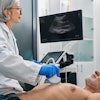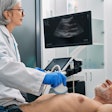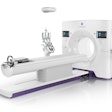Dear Cardiac Insider,
Third-generation dual-source CT (DSCT) has transitioned from approval to clinical use, and it comes with some novel built-in tools for addressing cardiac imaging problems, according to researchers from Germany.
The new scanner can deliver crisp images in standard coronary CT angiography, and rapidly deliver images long enough and fast enough to cover a triple rule-out scan in turbo cardiac scan mode. It also comes with tools for transcatheter aortic valve implantation planning, as well as diagnosing symptomatic cardiac disease with a fast stress cardiac perfusion protocol.
Find out more about third-generation DSCT for cardiac and see some images by clicking here.
Minimalist approach
CT coronary angiography (CCTA) has become the go-to modality for diagnosing suspected coronary disease, and what it does, it does very well: ruling out suspected coronary artery disease. But is CCTA really necessary for every patient with chest pain?
It is not, contend radiologists from the Netherlands, who are testing a controversial "tiered" plan that relies on CT for diagnosis -- but more often than not skips CCTA entirely. The Rotterdam group's protocol begins and usually ends with calcium scoring, and so far they seem to be getting away with it. Find out more about this group's tiered approach and its implications by clicking here.
CCTA for ruling out coronary disease has a well-known limitation, of course, inasmuch as it can't gauge the severity of coronary stenosis on its own. Based on CT attenuation, however, a software program is doing just that, and has proved successful in multicenter trials as it treads the path toward approval in the U.S. and Europe.
But an upstart software application is elbowing its way into the blood-flow assessment arena -- if you can call a large multinational OEM an upstart. The new program, investigational only at this point, promises to gauge the severity of CT-detected coronary stenosis onsite by measuring fractional flow reserve (FFR), without the need to send image files off to a laboratory for analysis by supercomputers. And it's fast.
Needless to say, there are questions about its accuracy that only more studies will answer. On the positive side, the new software is being tested by the same Rotterdam team, from Erasmus Medical Center, that is looking at the tiered approach to cardiac CT and so many other innovative techniques. Click here for more about FFR-CT the easy way.
We close with a tale of improbable diagnoses seemingly lost and then found at the Unidentified Disease Center in Marburg, Germany. In an era where extreme medical specialization is the norm, illnesses that crossover from one specialty to another can be daunting to diagnose -- unless you have a team of sleuths working to reveal the truth. Find out more about the center here.
As always, we hope you'll stay tuned to your Cardiac Imaging Digital Community to help solve the cardiac imaging mysteries that are happening in your life.



















